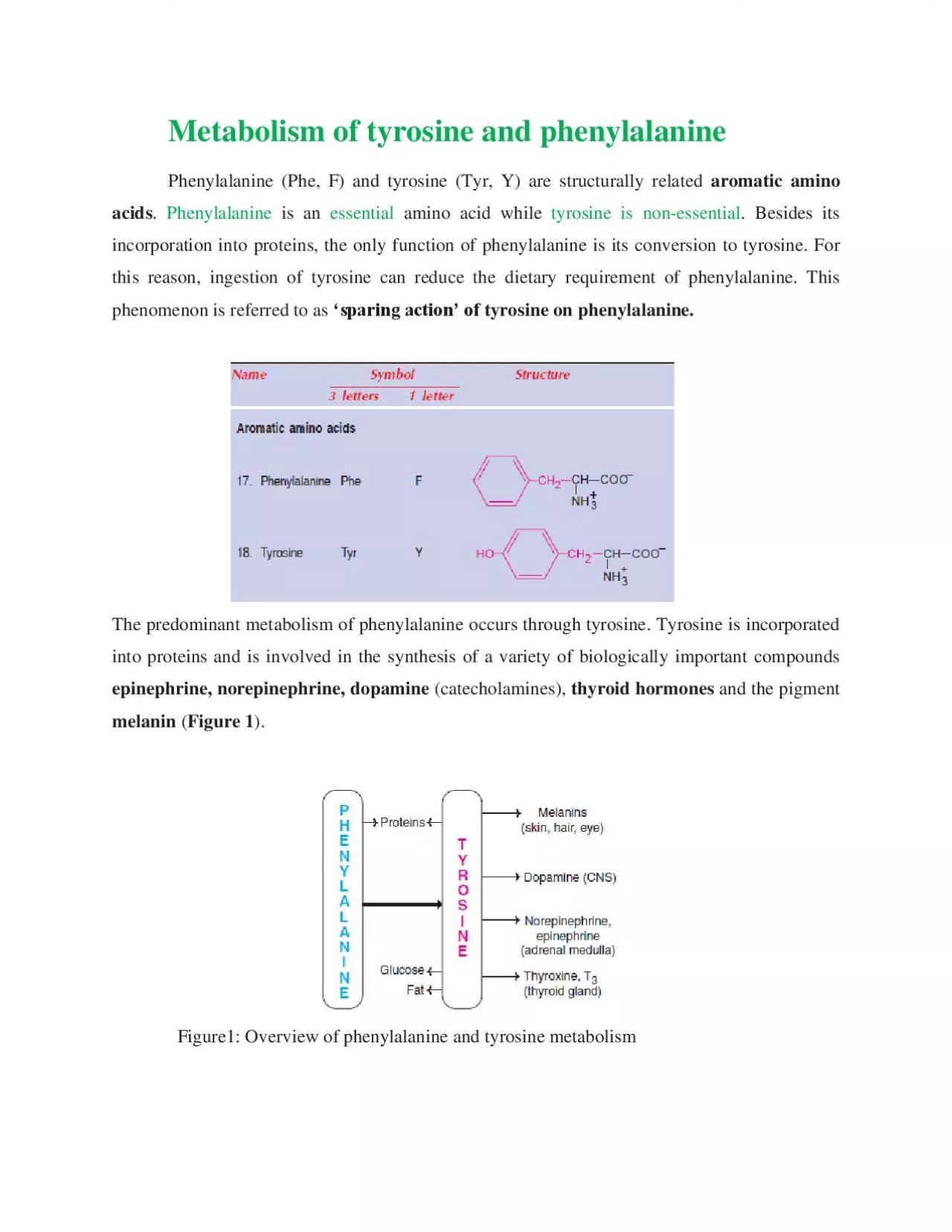

Phenylalanine Phe F and tyrosine Tyr Y are structurally related aromatic amino acids Phenylalanine is an essential amino acid while tyrosine is non essential Besides its incorporation i ID: 960527
Download Pdf The PPT/PDF document "Metabolism of tyrosine and phenylalanine" is the property of its rightful owner. Permission is granted to download and print the materials on this web site for personal, non-commercial use only, and to display it on your personal computer provided you do not modify the materials and that you retain all copyright notices contained in the materials. By downloading content from our website, you accept the terms of this agreement.
Metabolism of tyrosine and phenylalanine Phenylalanine (Phe, F) and tyrosine (Tyr, Y) are structurally related aromatic amino acids . Phenylalanine is an essential amino acid while tyrosine is non - essential . Besides its incorporation into proteins, the only function of phenylalanine is its conversion to tyrosine. For this reason, ingestion of tyrosine can reduce the dietary requirement of phenylalanine. This phenomenon is referred to as ‘sparing action’ of tyrosine on phenylalanine. The predominant metabolism of phenylalanine occurs through tyrosine. Tyrosine is incorporated into proteins and is involved in the synthesis of a variety of biologically important compounds epinephrine, norepineph rine, dopamine (catecholamines), thyroid hormones and the pigment melanin ( Fig ure 1 ). Figure1: Overview of phenylalanine and tyrosine metabolism During the course of degradation, phenylalanine and tyrosine are converted to metabolites which c
an serve as precursors for the synthesis of glucose and fat. Hence, these amino acids are both glucogenic and ketogenic . Conversion of phenylalanine to tyrosine Under normal circumstances, the degradation of phenylalanine mostly occurs through tyrosine. Phenylalanine is hydroxylated at para - position by phenylalanine hydroxylase to produce tyrosine (p - hydroxy phenylalanine). This is an irreversible reaction and requires the par ticipation of a specific coenzyme biopterin . The active form of biopterin is tetrahydrobiopterin (H4 - biopterin). In the phenylalanine hydroxylase reaction, tetrahydrobiopterin is oxidized to dihydrobiopterin (H2 - biopterin). Tetrahydrobiopterin is then rege nerated by an NADPH dependent dihydrobiopterin reductase . Figure2: Synthesis of tyrosine from phenylalanine The enzyme phenylalanine hydroxylase is present in the liver. In the conversion of phenylalanine to tyrosine, the reaction involves the incorporation of one atom of molecular oxygen (O 2 ) into the
para position of phenylalanine while the other atom of O 2 is reduced to form water. It is the te trahydrobiopterin that supplies the reducing equivalents which, in turn, are provided by NADPH. Due to a defect in phenylalanine hydroxylase , the conversion of phenylalanine to tyrosine is blocked resulting in the disorder phenylketonuria (PKU). DEGRADATION OF TYROSINE (PHENYLALANINE) The metabolism of phenylalanine and tyrosine is considered together. The sequence of the reactions in the degradation of these amino acids, depicted in Fig ure 2 , is described hereunder 1. As phenylalanine is converted to tyrosine , a single pathway is responsible for the degradation of both these amino acids, which occurs mostly in liver. 2. Tyrosine first undergoes transamination to give p - hydroxyphenylpyruvate. This reaction is catalysed by t yrosine transaminase (PLP dependent). 3. p - Hydroxyphenylpyruvate hydroxylase (or dioxygenase) is a copper - containing enzyme. It catalyses oxidative decarboxylation as well as hydrox ylation of the phenyl ring o
f p hydroxyphenylpyruvate to produce homogentis ate. This reaction involves a shift in hydroxyl group from para position to meta position, and incorporates a new hydroxyl group at para position. This step in tyrosine metabolism requires ascorbic acid. 4. Homogentisate oxidase (iron metalloprotein) cleav es the benzene ring of homogentisate to form 4 - maleylacetoacetate. 4. Homogentisate oxidase (iron metalloprotein) cleaves the benzene ring of homogentisate to form 4 - maleylacetoacetate. Molecular oxygen is required for this reaction to break the aromatic r ing. 5. Maleylacetoacetate undergoes isomerization to form 4 - fumaryl acetoacetate and this reaction is catalysed by maleylacetoacetate isomerase. 6. Fumaryl acetoacetase (fumaryl acetoacetate hydrolase) brings about the hydrolysis of fumaryl acetoacetate t o liberate fumarate and acetoacetate. Fumarate is an intermediate of citric acid cycle and can also serve as precursor for gluconeogenesis . Acetoacetate is a ketone body from which fat can be synthesized. Phenylalanine and ty
rosine are, therefore, both glu cogenic and ketogenic. The inborn errors of phenylalanine and tyrosine metabolism are indicated in Fi gure2 . Biosynthesis of thyroid hormones Thyroid hormones — thyroxine (tetraiodothyronine) and triiodothyronine — are synthesized from the tyrosine residues of the protein thyroglobulin and activated iodine ( Fig ure 4 ). Iodination of tyrosine ring occurs to produce mono - and diiodotyrosine from which triiodothyronine (T3) and thyroxine (T4) are synthesized. The protein thyroglobulin undergoes proteolytic breakdown to release the free hormones, T3 and T4 . Figure 3: Tyrosine metabolism — degradative pathway [ α KG – α - Ketoglutarate; Glu - Glutamate; The circled numbers indicate metabolic defects (1) Phenylketonuria; (2) Tyrosinemia type II; (3) Neonatal tyrosinemia; (4) Alkaptonuria; (5) and (6) Tyrosinosis (tyrosinemia, type I)]. Figure 4: : Metabolism of tyrosine : synthesis of thyroid hormones